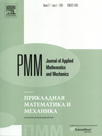 | | Journal of Applied
Mathematics and Mechanics
Russian Academy of Sciences | | Founded
in January 1936
(Translated from 1958)
Issued 6 times a year
ISSN 0021-8928
(print version) |
Archive of Issues
| Total articles in the database: | | 10610 |
| In Russian (¤╠╠): | | 9811
|
| In English (J. Appl. Math. Mech.): | | 799 |
|
| << Previous article | Volume 73, Issue 4 / 2009 | Next article >> |
| Ye.V. Glushkov, N.V. Glushkova, A.A. Yeremin, and V.V. Mikhasĺkiv, "The layered element method in the dynamic theory of elasticity," J. Appl. Math. Mech. 73 (4), 449-456 (2009) |
| Year |
2009 |
Volume |
73 |
Issue |
4 |
Pages |
449-456 |
| Title |
The layered element method in the dynamic theory of elasticity |
| Author(s) |
Ye.V. Glushkov (Krasnodar, Russia, evg@math.kubsu.ru)
N.V. Glushkova (Krasnodar, Russia)
A.A. Yeremin (Krasnodar, Russia)
V.V. Mikhasĺkiv (Lviv, Ukraine) |
| Abstract |
A semi-analytical approach is proposed for the numerical analysis of the dynamic behaviour of elastic layered systems and waveguides with internal and surface nonuniformities. The approach is based on representing the reflected field in the form of an expansion in fundamental solutions for the layered structure as a whole. Unlike classical boundary elements, which represent the fundamental solutions for a homogeneous elastic space, layered elements identically satisfy the boundary conditions on all outer and inner plane-parallel boundaries. Hence, to find the unknown expansion coefficients it is necessary to satisfy boundary conditions only on obstacles, that assumes the use of many fewer elements than in the boundary element method, using which it is necessary to arrange them along all the outer and inner boundaries of the region considered. Moreover, each layered element exactly describes the wave structure of the solution, which is particularly convenient when solving problems of the transmission and reflection of travelling waves in open waveguides with obstacles. A brief description of an algorithm for constructing layered elements is given and examples of the use of the layered element method for solving two-dimensional and three-dimensional problems of diffraction in an open waveguide, and also for calculating the dynamic characteristics of bounded structural elements, made of laminated materials, are presented. |
| Received |
02 July 2008 |
| Link to Fulltext |
|
| << Previous article | Volume 73, Issue 4 / 2009 | Next article >> |
|
 If you find a misprint on a webpage, please help us correct it promptly - just highlight and press Ctrl+Enter If you find a misprint on a webpage, please help us correct it promptly - just highlight and press Ctrl+Enter
|
|

 Russian
Russian  English
English